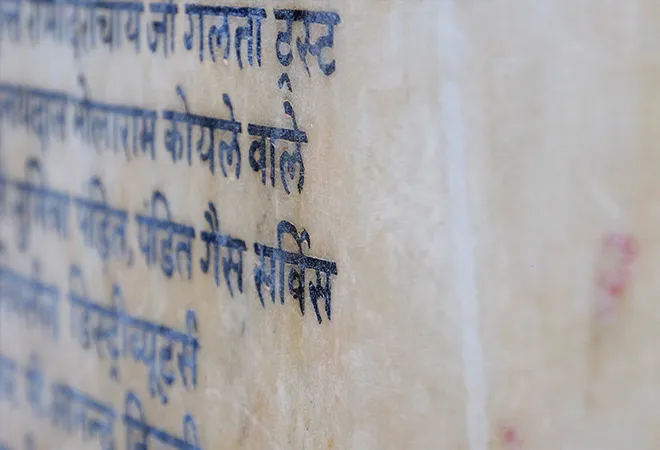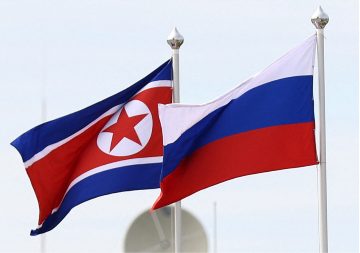
It is somewhat surprising to see that the draft of the National Education Policy by the Ministry of Human Resource Development, Government of India was allowed to create misgivings and public outcry for a few days before the government decided to douse a possible (or almost certain) flame by insisting that it was simply a “Draft” and by re-writing P4.5.9 in the draft to remove the implied compulsion of non-Hindi speaking states to include Hindi in the school curriculum.
Our language policy was taken as ‘settled’ since the 1960s. In 1959 as well as in 1963, Prime Minister Jawaharlal Nehru gave a solemn undertaking on behalf of the Government of India that the government was committed to a
relaxed Three-Language Formula under which Hindi would be the official language with English continuing in parallel with it until the non-Hindi speaking people agree to the abolition of the latter. The Constitution had already kept the window open for indefinite continuation of English (Article 343-3)). Accordingly, the Official Languages Act was passed in 1963 permitting continuation of English beyond the first 15 years of the Constitution.
I use the word ‘relaxed’ because it was nearly clear that, come what may, neither Tamil Nadu nor the north Indian states would do much to implement a three-language formula. The maximum they would do was to teach English in some form in addition to their native language and leave the rest for individuals to decide. Our honest experience during the last nearly sixty years has confirmed such a belief.
Dr. Kasturirangan has in this new Draft, broadly followed the spirit in which the issue was earlier resolved The last paragraph of the Preamble to the Draft says:
The National Education Policy 2019 provides a framework for the transformation and re-invigoration of the education system in order to respond to the requirements of fast-changing, knowledge-based societies while taking into account the diversity of the Indian people, their traditions, cultures, and languages. Nothing in this sounds offensive
.
While discussing the language question in education, the report says (Section 4.5):
The Policy further recognises the large numbers of students going to school to classes that are being conducted in a language that they do not understand, causing them to fall behind before they even start learning. Thus there is a strong need for classes in early years to be conducted in students’ local languages. In the following subsection the report reminds us that minority students having different languages other than the prevalent local language should also have equal facility to learn in their own native language. It speaks of a “flexible language approach in the class room.”
On the three-language formula, the Draft without question rests on the policy followed since 1968 which, it recommends, “will be continued, keeping in mind the Constitutional provisions and aspirations of the people, regions, and the Union.” But it also admits (4.5.6) it needs to be implemented “in spirit” implying that it has not been so implemented till now for which it politely reminds the Hindi speaking states of their bigger responsibility.
On the specific issue of teaching three languages in schools (4.5.3), the Draft says:
To leverage the enhanced language-learning abilities of young children, all students from pre-school and Grade 1 onwards will be exposed to three or more languages with the aim of developing speaking proficiency and interaction, and the ability to recognise scripts and read basic text, in all three languages by Grade 3.
This in fact, is an excellent idea provided we keep the curriculum at this stage limited only to languages and elementary math by holding all other subjects for later years through the process of restructuring the syllabus. Otherwise, we will overburden the mind and thinking capacity of the young. Here of course the ideas of Aristotle, Rousseau, Montessori and Tagore — all of whom had definite views on education during the first seven years of a childs’ life, would be very relevant. But we need not go into it at this moment.
On the three-language formula, the Draft without question rests on the policy followed since 1968 which, it recommends, “will be continued, keeping in mind the Constitutional provisions and aspirations of the people, regions, and the Union.” But it also admits (4.5.6)that it needs to be implemented “in spirit” implying that it has not been so implemented till now for which it politely reminds the Hindi speaking states of their bigger responsibility:
However, it must be better implemented in certain States, particularly Hindi-speaking States; for purposes of national integration, schools in Hindi-speaking areas should also offer and teach Indian languages from other parts of India.
The problem is if the Draft finds the Hindi speaking states not sincerely implementing the three-language formula, as the above paragraph shows, it should not have imposed the responsibility of teaching Hindi for non-Hindi speaking states in a following sub-paragraph (which has been removed in the revised draft). There is also the need to be more specific than merely asking Hindi-speaking states for teaching “Indian languages from other parts of India.”
The kind of reaction that only one-and-half line in the original draft — inadvertently or intentionally inserted, produced shows how sensitive the language issue still is and may remain forever. Each language is equally precious to its speakers and no theory of majoritarianism can resolve the issue.
As of 2011 Census, Hindi speakers constitute 43.6 per cent of the people and this figure is arrived at by including within this category language groups speaking Bhojpuri, Maithili, Marwari and such other small language groups. So, at best Hindi speakers constitute a plurality and the size of the plurality is somewhat inflated. Besides, this also raises another issue: the Hindi speakers are growing much faster than Dravidian language speakers implying that they are not observing family planning norms compared to other language groups.
The status of a language often depends on the status of the country or region where its speakers live. English is respected because of the achievements of Great Britain. Today Mandarin has become a respected language which many people want to learn because of the development China has achieved. The Indian state’s overwhelming support to Hindi since independence has not made the Hindi speaking states role models for other states. A rank-order for 23 Indian states in terms of their achievement in sustainable development goals has recently been developed by Nilanjan Ghosh et al at ORF, Kolkata. The index shows the four south Indian states among the first seven while Chhatisgarh, Madhya Pradesh, Jharkhand, UP and Bihar occupy 17th, 18th, 21st, 22nd, and 23rd positions respectively.
In terms of attracting domestic tourists in India, Tamil Nadu is ranked 1st capturing 20.9 per cent of domestic tourists in 2017 which shows the poor Hindi speaking ability of the local people there does not deter tourists from all over India to visit the state.
The kind of reaction that only one-and-half line in the original draft — inadvertently or intentionally inserted, produced shows how sensitive the language issue still is and may remain forever. Each language is equally precious to its speakers and no theory of majoritarianism can resolve the issue.
The Draft’s discussion of English language teaching is clumsy. It identifies the language with ‘colonists’ and ‘economic elites’ and finds a ‘power structure of language’ which it recommends should without delay be abolished (82-83). In the same breadth, it also recommends that “English must also be available and taught in high quality manner at all government and non-government schools.” Although the Draft believes English has not become an “international language as expected,” it suggests students must acquire proficiency in it for higher education in science and technology. One wonders if it would not create a new structure of power debarring the humanities students from entering into it!
Putting language off the agenda of politics was one of Nehru’s major contributions. Why some people thought it was time to bring back the idea of imposing Hindi on all Indians is a riddle. Robert D. King in his
Nehru and the Language Politics of India (Oxford, 1997) wrote, “Language problems are almost never as they appear to be: they are often camouflage to hide agendas weakly linked to language.” This may help us solve the riddle.
(
The article was updated on 15 June 2019.)
The views expressed above belong to the author(s). ORF research and analyses now available on Telegram! Click here to access our curated content — blogs, longforms and interviews.



 It is somewhat surprising to see that the draft of the National Education Policy by the Ministry of Human Resource Development, Government of India was allowed to create misgivings and public outcry for a few days before the government decided to douse a possible (or almost certain) flame by insisting that it was simply a “Draft” and by re-writing P4.5.9 in the draft to remove the implied compulsion of non-Hindi speaking states to include Hindi in the school curriculum.
Our language policy was taken as ‘settled’ since the 1960s. In 1959 as well as in 1963, Prime Minister Jawaharlal Nehru gave a solemn undertaking on behalf of the Government of India that the government was committed to a relaxed Three-Language Formula under which Hindi would be the official language with English continuing in parallel with it until the non-Hindi speaking people agree to the abolition of the latter. The Constitution had already kept the window open for indefinite continuation of English (Article 343-3)). Accordingly, the Official Languages Act was passed in 1963 permitting continuation of English beyond the first 15 years of the Constitution.
I use the word ‘relaxed’ because it was nearly clear that, come what may, neither Tamil Nadu nor the north Indian states would do much to implement a three-language formula. The maximum they would do was to teach English in some form in addition to their native language and leave the rest for individuals to decide. Our honest experience during the last nearly sixty years has confirmed such a belief.
Dr. Kasturirangan has in this new Draft, broadly followed the spirit in which the issue was earlier resolved The last paragraph of the Preamble to the Draft says: The National Education Policy 2019 provides a framework for the transformation and re-invigoration of the education system in order to respond to the requirements of fast-changing, knowledge-based societies while taking into account the diversity of the Indian people, their traditions, cultures, and languages. Nothing in this sounds offensive.
While discussing the language question in education, the report says (Section 4.5): The Policy further recognises the large numbers of students going to school to classes that are being conducted in a language that they do not understand, causing them to fall behind before they even start learning. Thus there is a strong need for classes in early years to be conducted in students’ local languages. In the following subsection the report reminds us that minority students having different languages other than the prevalent local language should also have equal facility to learn in their own native language. It speaks of a “flexible language approach in the class room.”
It is somewhat surprising to see that the draft of the National Education Policy by the Ministry of Human Resource Development, Government of India was allowed to create misgivings and public outcry for a few days before the government decided to douse a possible (or almost certain) flame by insisting that it was simply a “Draft” and by re-writing P4.5.9 in the draft to remove the implied compulsion of non-Hindi speaking states to include Hindi in the school curriculum.
Our language policy was taken as ‘settled’ since the 1960s. In 1959 as well as in 1963, Prime Minister Jawaharlal Nehru gave a solemn undertaking on behalf of the Government of India that the government was committed to a relaxed Three-Language Formula under which Hindi would be the official language with English continuing in parallel with it until the non-Hindi speaking people agree to the abolition of the latter. The Constitution had already kept the window open for indefinite continuation of English (Article 343-3)). Accordingly, the Official Languages Act was passed in 1963 permitting continuation of English beyond the first 15 years of the Constitution.
I use the word ‘relaxed’ because it was nearly clear that, come what may, neither Tamil Nadu nor the north Indian states would do much to implement a three-language formula. The maximum they would do was to teach English in some form in addition to their native language and leave the rest for individuals to decide. Our honest experience during the last nearly sixty years has confirmed such a belief.
Dr. Kasturirangan has in this new Draft, broadly followed the spirit in which the issue was earlier resolved The last paragraph of the Preamble to the Draft says: The National Education Policy 2019 provides a framework for the transformation and re-invigoration of the education system in order to respond to the requirements of fast-changing, knowledge-based societies while taking into account the diversity of the Indian people, their traditions, cultures, and languages. Nothing in this sounds offensive.
While discussing the language question in education, the report says (Section 4.5): The Policy further recognises the large numbers of students going to school to classes that are being conducted in a language that they do not understand, causing them to fall behind before they even start learning. Thus there is a strong need for classes in early years to be conducted in students’ local languages. In the following subsection the report reminds us that minority students having different languages other than the prevalent local language should also have equal facility to learn in their own native language. It speaks of a “flexible language approach in the class room.”
 PREV
PREV


